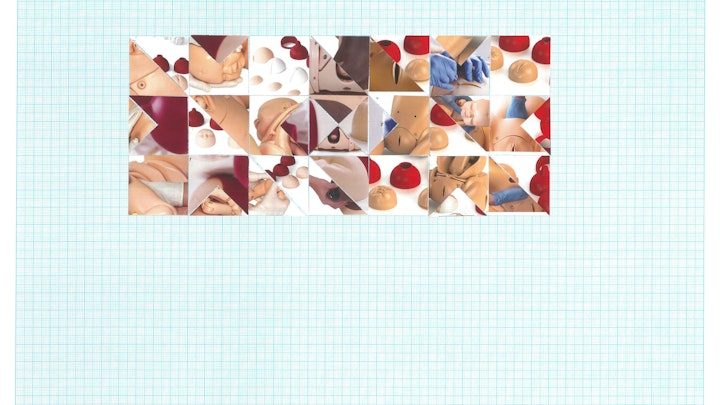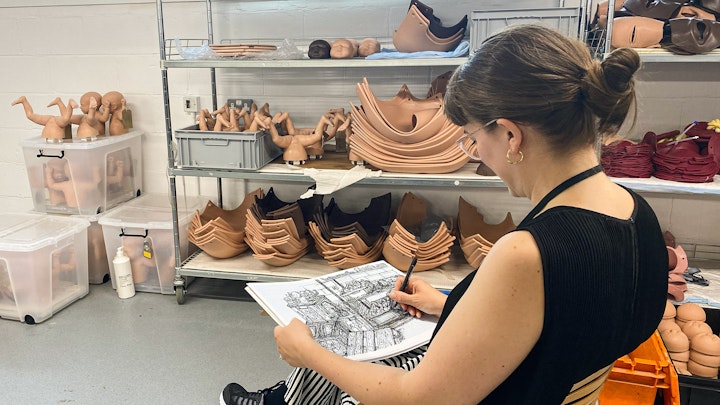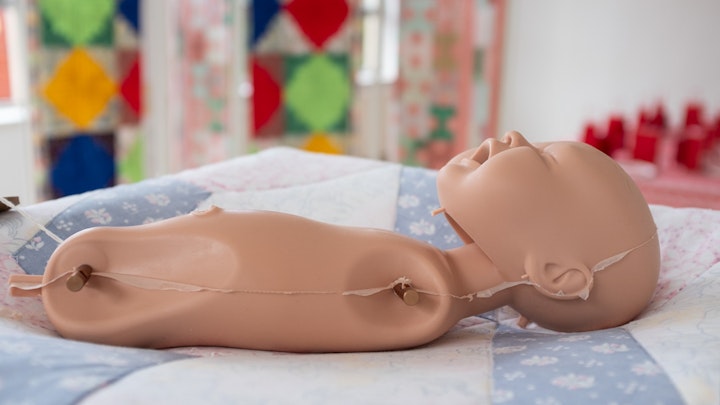Limbs & Things Residency
residencies
The Catalogue Series
6 collages on A3 graph paper
2023
The Catalogue Series is a series of 6 collages created during a residency with medical simulator company Limbs & Things. The work repurposes archival catalogue images of the company's midwifery training products as paper quilts on graph paper. The traditional quilt block patterns splice together glimpsed triangles, hexagons and diamonds of products ranging from episiotomy suture training models; breastmilk expression trainers; placentas and umbilical cords; and new born babies from their PROMPT birthing trainers for training on C-sections and a range of other birth interventions and delivery techniques. Each collage focuses on products from a year or two year span, selected at random intervals throughout Limbs & Things' 33 years in industry, from their founding in 1990 by medical illustrator Margot Cooper. The collages are a visual representation of product changes, improvements, adaptations and discontinuations, indicating much wider, complex changes in approaches to clinical birth training and new motherhood around the world.
These pieces informed a series of sculptural works Held with Volume (2023) using found quilts and seconds from the Limbs & Things midwifery training products.
RESIDENCY BACKGROUND
I first came across Limbs & Things on my way home one day, walking through the industrial estate surrounding my home in Barton Hill, I glanced through the open shutter of a warehouse I was passing to see shelves upon shelves of body parts. Rows of torsos stood to attention; arms with hands outstretched lay waiting for something unknown; and various human organs blobbed around together in black boxes. I wanted to know more.
As an artist the uncanny is undeniably curious, but following some research into the company I realised my interests with Limbs & Things were aligned on many levels. My fascination in the crossover of arts and science, research and human experience, handmade craft and human-centred design were all part of the ethos of Limbs & Things - a company making medical simulator models for training clinicians.
I decided to reach out to Limbs & Things to ask if I could see behind the curtain, and come in to the factory and office as an artist in residence - to creatively explore and respond to these interests through visual research and art making on site. I was thrilled when they responded, and offered a factory tour to talk through ideas and see what would work for us both.
I am particularly interested in birth experiences, and wanted to explore the many models Limbs & Things produce for clinical training in midwifery and obstetrics. During my initial tour I was given the chance to deliver a c-section baby from their Ceasarian training simulator - a layered model of a pregnant woman, from top of the bump to midway through the thighs with a surgical slice already in position for delivery. Gloved up and (model!) baby in position, I was invited to insert my hand through the surgical opening, down into the pelvis to attempt to get my fingers in the very tight space between baby’s head and the pelvis. The aim is to break the air seal here, releasing the baby’s head and pushing them back up into the abdomen, before bringing them out of the opening head first to be born! Having had a C-section myself, it was a rather bizarre experience, but already I felt it gave me an understanding of the challenges faced by the medical team and greater empathy in the decision making involved.
I developed a loose proposal of time and rough aims for my creative activities: a 6 week residency of Thursday mornings based at the Limbs & Things office, working on collage, drawing, and possible filming as research for larger sculptural works to be developed at a later date. I was delighted when my proposal was approved, and began the residency in June.
RESIDENCY PROCESS
During the residency I was stationed on the recently redeveloped mezzanine floor of the Limbs & Things HQ, where factory lines are beginning to take shape and there is constant bustle and movement of products being assembled, transported, unpacked and repacked. Piles of silicon hand skins lay awaiting their digital innards like rubber gloves, wearable breasts have various cancer simulations inserted into their artificial tissue and cherry red cervixes at various stages of dilation line up ready to be shipped out. The friendly staff made me feel so welcome as I joined the production floor, setting up a temporary studio every Thursday where I would begin my own manufacturing process: carefully slicing images from the archival product catalogues, rearranging them into paper quilt blocks as I reflected on the power of these products to simulate real body parts, their haptics carefully designed to feel realistically soft, silky, ridged, stretchy and firm. Enabling clinical training on simulation models rather than on real human patients through these wonderfully, uncannily realistic models and expert design processes, Limbs & Things straddles the worlds of medicine, design and art in a fascinating way.
Learning about the medical processes and the impact these products have had was enlightening - I was told that midwifery training at Southmead Hospital using the PROMPT Flex birth trainer to avoid shoulder dystocia has eradicated cases of it happening there completely. The feedback from clinicians is well absorbed into the design process and I was pleasantly surprised that these products are not designed with built-in obsolesce, rather they are designed in parts to assemble and change for different procedures, and where improvements need to be made new products are created to add on to existing ones, rather than render a whole line of products unusable.
Through this residency I began to explore the tensions between the home birth and medical birth approaches (and all the complexities which sit within each). I am very interested in this space between - the fine lines and the overlaps between recommendations, expectations and advice around birth experiences from all shades of the spectrum. I hope these works speak to this in some form: bringing the domestic, new-baby nurturing and intergenerational spoken and unspoken birth traumas and triumphs represented in the quilt patterns together with the medical processes, practicalities and procedures which many birthing people have experienced privately into a shared public. Hopefully a public which can begin, continue and prompt conversation on the complexities and dualities within the birth experience.











